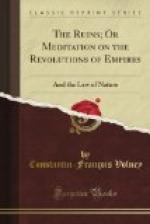* See the Chronology
of the Twelve Ages, in which I conceive
myself to have clearly
proved that Moses lived about 1,400
years before Jesus Christ,
and Zoroaster about a thousand.
“Thus,” continued the Mobed, turning to the Rabbins, “it was not till after that epoch, that is to say, in the time of your first kings, that these ideas began to appear in your writers; and then their appearance was obscure and gradual, according to the progress of the political relations between your ancestors and ours. It was especially when, having been conquered by the kings of Nineveh and Babylon and transported to the banks of the Tygris and the Euphrates, where they resided for three successive generations, that they imbibed manners and opinions which had been rejected as contrary to their law. When our king Cyrus had delivered them from slavery, their heart was won to us by gratitude; they became our disciples and imitators; and they admitted our dogmas in the revision of their books;* for your Genesis, in particular, was never the work of Moses, but a compilation drawn up after the return from the Babylonian captivity, in which are inserted the Chaldean opinions of the origin of the world.
* In the first periods of the Christian church, not only the most learned of those who have since been denominated heretics, but many of the orthodox conceived Moses to have written neither the law nor the Pentateuch, but that the work was a compilation made by the elders of the people and the Seventy, who, after the death of Moses, collected his scattered ordinances, and mixed with them things that were extraneous; similar to what happened as to the Koran of Mahomet. See Les Clementines, Homel. 2. sect. 51. and Homel. 3. sect. 42.
Modern critics, more enlightened or more attentive than the ancients, have found in Genesis in particular, marks of its having been composed on the return from the captivity; but the principal proofs have escaped them. These I mean to exhibit in an analysis of the book of Genesis, in which I shall demonstrate that the tenth chapter, among others, which treats of the pretended generations of the man called Noah, is a real geographical picture of the world, as it was known to the Hebrews at the epoch of the captivity, which was bounded by Greece or Hellas at the West, mount Caucasus at the North, Persia at the East, and Arabia and Upper Egypt at the South. All the pretended personages from Adam to Abraham, or his father Terah, are mythological beings, stars, constellations, countries. Adam is Bootes: Noah is Osiris: Xisuthrus Janus, Saturn; that is to say Capricorn, or the celestial Genius that opened the year. The Alexandrian Chronicle says expressly, page 85, that Nimrod was supposed by the Persians to be their first king, as having invented the art of hunting, and that he was translated into heaven, where he appears under the name of Orion.
“At first the pure followers of the law, opposing to the emigrants the letter of the text and the absolute silence of the prophet, endeavored to repel these innovations; but they ultimately prevailed, and our doctrine, modified by your ideas, gave rise to a new sect.




